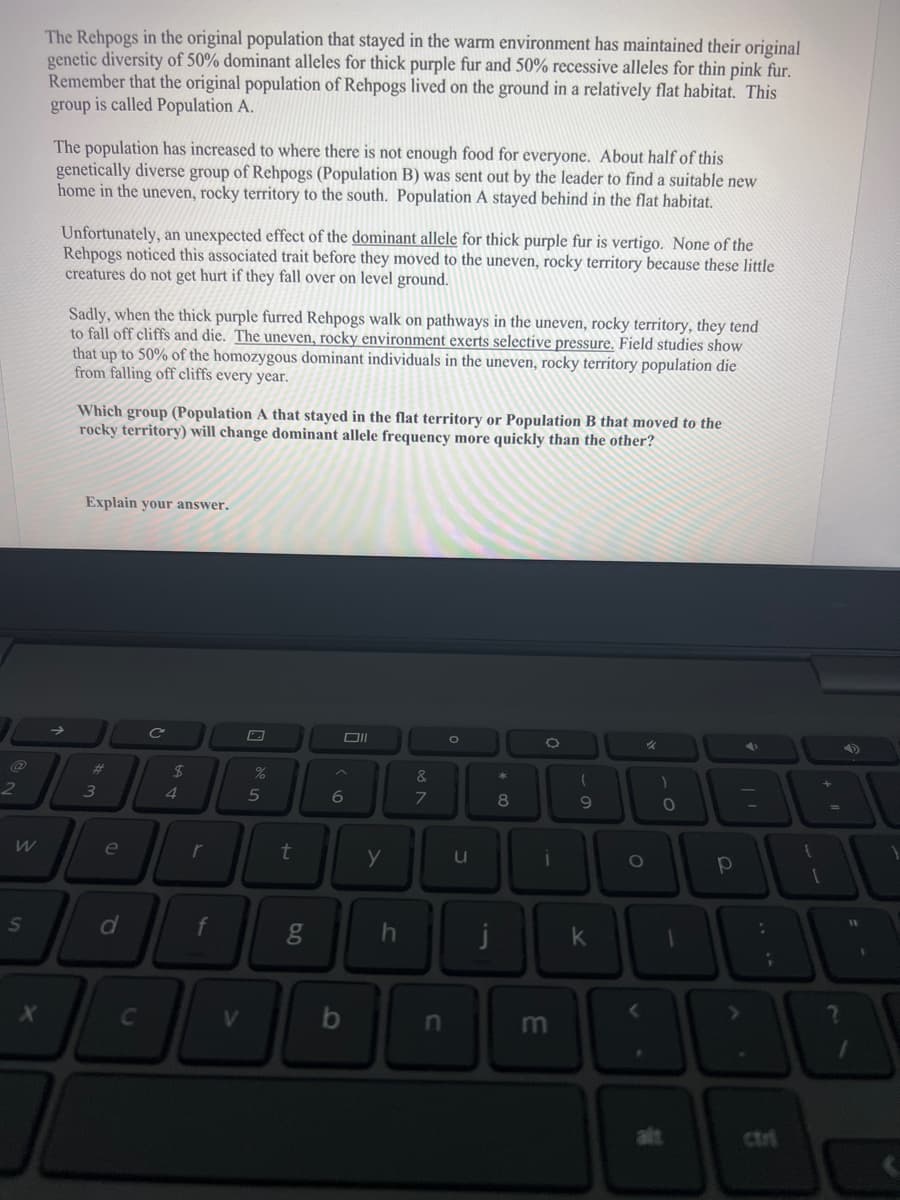W S Rehpogs are mythical creatures. They are small and not very smart. Rehpogs live on the ground in a flat, warm habitat. Their fur texture and color ranges from thick purple fur to thin pink fur, depending on allele distribution. The dominant fur allele (R) codes for thick purple fur. The recessive allele (r) codes for thin pink fur. REMEMBER: a phenotype (fur color) is the physical expression of a genotype (two- letter code for the alleles present in that individual). Each individual has two alleles for fur color: RR genotype is homozygous dominant = Thick purple fur phenotype Rr genotype is heterozygous = Thick purple fur (because of the presence of one dominant allele) rr genotype is homozygous recessive = Thin pink fur (because of the absence of a dominant allele) For the purposes of this experiment, Rehpogs mate once per year and produce two offspring each year. Rehpogs are monogamous, faithful and fertile. →>> # 3 e d C C $ 4 r f de s % 5 0 V t g Oll A 6 y b h & 7 O 30 n u j 00 * 8 O i m ( 9 k O < % ) O alt р 7 ; ctrl { 1 + ?
W S Rehpogs are mythical creatures. They are small and not very smart. Rehpogs live on the ground in a flat, warm habitat. Their fur texture and color ranges from thick purple fur to thin pink fur, depending on allele distribution. The dominant fur allele (R) codes for thick purple fur. The recessive allele (r) codes for thin pink fur. REMEMBER: a phenotype (fur color) is the physical expression of a genotype (two- letter code for the alleles present in that individual). Each individual has two alleles for fur color: RR genotype is homozygous dominant = Thick purple fur phenotype Rr genotype is heterozygous = Thick purple fur (because of the presence of one dominant allele) rr genotype is homozygous recessive = Thin pink fur (because of the absence of a dominant allele) For the purposes of this experiment, Rehpogs mate once per year and produce two offspring each year. Rehpogs are monogamous, faithful and fertile. →>> # 3 e d C C $ 4 r f de s % 5 0 V t g Oll A 6 y b h & 7 O 30 n u j 00 * 8 O i m ( 9 k O < % ) O alt р 7 ; ctrl { 1 + ?
Biology Today and Tomorrow without Physiology (MindTap Course List)
5th Edition
ISBN:9781305117396
Author:Cecie Starr, Christine Evers, Lisa Starr
Publisher:Cecie Starr, Christine Evers, Lisa Starr
Chapter12: Processes Of Evolution
Section: Chapter Questions
Problem 4SQ
Related questions
Question

Transcribed Image Text:@
2
W
S
Rehpogs are mythical creatures. They are small and not very smart. Rehpogs live on the ground in a flat,
warm habitat. Their fur texture and color ranges from thick purple fur to thin pink fur, depending on
allele distribution. The dominant fur allele (R) codes for thick purple fur. The recessive allele (r) codes
for thin pink fur. REMEMBER: a phenotype (fur color) is the physical expression of a genotype (two-
letter code for the alleles present in that individual). Each individual has two alleles for fur color:
X
RR genotype is homozygous dominant = Thick purple fur phenotype
Rr genotype is heterozygous = Thick purple fur (because of the presence of one dominant allele)
rr genotype is homozygous recessive = Thin pink fur (because of the absence of a dominant allele)
For the purposes of this experiment, Rehpogs mate once per year and produce two offspring each year.
Rehpogs are monogamous, faithful and fertile.
#
3
e
d
C
C
$
4
r
f
V
%
5
t
g
Oll
6
b
y
h
&
7
O
8
n
JL
u
i
j
O
L
m
(
9
k
O
<
14
)
O
alt
р
-
:
;
ctrl
{
[
+
?

Transcribed Image Text:2
W
S
X
The Rehpogs in the original population that stayed in the warm environment has maintained their original
genetic diversity of 50% dominant alleles for thick purple fur and 50% recessive alleles for thin pink fur.
Remember that the original population of Rehpogs lived on the ground in a relatively flat habitat. This
group is called Population A.
The population has increased to where there is not enough food for everyone. About half of this
genetically diverse group of Rehpogs (Population B) was sent out by the leader to find a suitable new
home in the uneven, rocky territory to the south. Population A stayed behind in the flat habitat.
Unfortunately, an unexpected effect of the dominant allele for thick purple fur is vertigo. None of the
Rehpogs noticed this associated trait before they moved to the uneven, rocky territory because these little
creatures do not get hurt if they fall over on level ground.
Sadly, when the thick purple furred Rehpogs walk on pathways in the uneven, rocky territory, they tend
to fall off cliffs and die. The uneven, rocky environment exerts selective pressure. Field studies show
that up to 50% of the homozygous dominant individuals in the uneven, rocky territory population die
from falling off cliffs every year.
Which group (Population A that stayed in the flat territory or Population B that moved to the
rocky territory) will change dominant allele frequency more quickly than the other?
Explain your answer.
3
e
C
$
4
r
f
V
¹ de
%
5
t
s'Q
g
6
b
y
h
&
V po
N
7
O
u
j
*
8
O
i
m
(
9
k
✓
O
<
F
)
O
-
р
D
:
;
{
+
1
?
Expert Solution
This question has been solved!
Explore an expertly crafted, step-by-step solution for a thorough understanding of key concepts.
Step by step
Solved in 2 steps

Knowledge Booster
Learn more about
Need a deep-dive on the concept behind this application? Look no further. Learn more about this topic, biology and related others by exploring similar questions and additional content below.Recommended textbooks for you

Biology Today and Tomorrow without Physiology (Mi…
Biology
ISBN:
9781305117396
Author:
Cecie Starr, Christine Evers, Lisa Starr
Publisher:
Cengage Learning

Biology Today and Tomorrow without Physiology (Mi…
Biology
ISBN:
9781305117396
Author:
Cecie Starr, Christine Evers, Lisa Starr
Publisher:
Cengage Learning